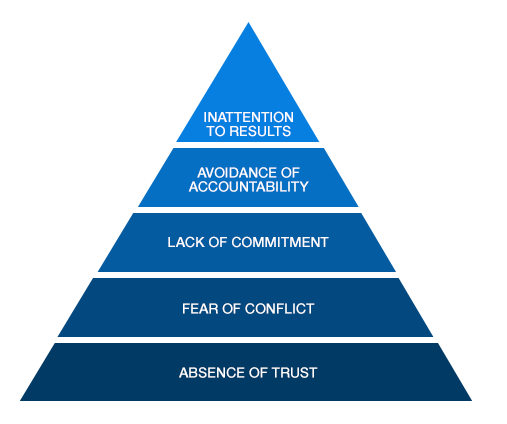How to build a great startup board (hint: your board is not your boss)
How to turn your board into your greatest ally, get more support, feel less alone, and do your damn job.

Having not slept much the night before, I was nervously nibbling on animal crackers provided by the co-working space in big Costco-style containers. As I waited for my lead investor to arrive, I gulped down my second cup of coffee.
It was my very first board meeting, and I had no idea what I was doing.
Although I had been running my startup for three years, I had never had a board before. To be honest, even with an MBA under my belt, I did not really know what a board was supposed to do or how it was supposed to work.
As the meeting started, I walked my one board member through the long deck I had meticulously prepared.
I spent the next two hours trying to convince her that I was doing a good job of running the company she had invested in only a couple of months earlier.
The meeting was one long, dull update followed by a few questions and some polite conversation.
A total waste of time.
It was not my investor's fault at all. It was mine.
I did not know what I was doing.
I had never even been to a board meeting before. My picture of a board was comprised mainly from movies I had seen as a kid where the board is portrayed as a group of twenty old white guys sitting around a wood table in a dimly lit room.
In hindsight, it is embarrassing.
When I hired my first CEO coach, one of the areas we explored in our early work was my relationship with my board.
He challenged me to begin to think of my board members as partners. He pushed me to risk bringing questions and emotions to the board instead of answers and stoic resolve.
As I began to risk openness with my board, the sense of aloneness that characterized much of my early years as CEO lifted.
We moved into real partnership.
By the time we sold the company in early 2019, things had changed dramatically. We had an extremely close board comprised of our lead investor, a prior head of product at a public-incumbent, an experienced CEO from a later-stage SAAS startup, and me.
Our board functioned as a high-trust, high-impact team built on trust, openness, intimacy, and clear expectations.
My board became a source of support, friendship, and tremendous intellectual brainpower around the company's most challenging problems.
If that kind of support and partnership from your board sounds like a pipe dream, read on.
If I can build high impact board, so can you.
The board as boss
Most CEOs I meet treat their board like their boss.
Yes, the board does hold the accountability of hiring (and at times firing) the CEO. That is true.
But holding that one accountability as the framing for the relationship results in a setup for disaster.
If you are a CEO, and you hire a head of product, for sure one of your accountabilities in that relationship is to continue to evaluate over time whether that person is the right fit for the job.
But that is not the heart of your work.
The heart of your work with that individual is to partner with her on the company's product strategy. To ensure she has the support, clarity, and resources necessary to thrive in her role.
How might you hold your perspective on your board differently if you view their accountability as helping you to flourish in the CEO role? What if the board's primary role is to help shoulder the massive CEO accountabilities of:
- Holding the company vision
- Recruiting and retaining the senior team
- Resourcing the team with capital and clarity
A good board support you and help you to excel at each of these accountabilities.
A great board will also go one step further and actually help you see around corners. When we were chewing on this post together, Bullpen Capital partner Duncan Davidson noted:
A great board will spot problems or issues ahead of the CEO. This is where broader perspective and experience can shine. Often the moment of great opportunity or risk is not recognized until it has passed.
A great board will help you improve in your role as CEO through support, trust, and partnership and help you lift your head up to see more of the game board. To get there, we need to turn this ragtag bunch into a high-function team.
Don't worry; you've got this. Let's begin.
What do you already know about great teams?
You probably already know a lot about high-function teams.
Think about the best experience of teamwork you have ever been a part of. It might be a sports team in high school, a debate team, or any other time you have had the feeling of:
"This is it! This is what happens when humans pull together and work really well together toward a common goal."
Now, take a moment and write down the values or characteristics that team possessed. Make your own list, but a few that I hear often to get your mind flowing include:
- Trust
- Intimacy
- Fun
- etc.
Take a moment and note down your own list.
This list represents your own experience, based on your own data, of the characteristics necessary for a high-impact team. Nice work!
Now, add a second column next to your list and title it 'Pinnacle Team' or whatever name you would like to give the team you are holding in your mind.
Score that team across each of the key characteristics you noted. If you noted 'Trust' for example, rate that team on a scale from 1 (no trust) to 10 (very high trust).
You can average the scores to get a sense for how high-function that pinnacle team was based on your own model.
Now add a third column and title it 'Board.'
Next, go through each characteristic and score your current board.
You can average the scores of your board to get a sense for where your board current lies on a scale of disfunction to high-function based on your personal model of teamwork.
Now you have a starting map for the work ahead. Values where your board ranks low are areas for improvement.
You might ask why you get to set the scorecard. Why should you get to decide what makes a great team? I would suggest two things:
- There are probably some universalities to the values you identified
- This is your company. You are the CEO. The board is yours to shape in the way that best serves you and the company. So if you are not going to set the standard for high-function, who will?
Getting the right people on the bus
In addition to inviting CEOs to shape their own scorecard for high-function, which I love to do early on in coaching work, I am a big fan of the idea presented in Good to Great of focusing first on getting the right people on this bus.
In Good to Great, Jim Collins analyzes companies that outperformed competitors in their space:
Collins and his research team identified a set of elite companies that made the leap to great results and sustained those results for at least fifteen years. How great? After the leap, the good-to-great companies generated cumulative stock returns that beat the general stock market by an average of seven times in fifteen years, better than twice the results delivered by a composite index of the world's greatest companies, including Coca-Cola, Intel, General Electric, and Merck.
In the study, Jim's team noted that great leaders begin with the following straightforward effort:
- Get the right people on the bus.
- Get the wrong people off the bus.
I often hear CEOs talk about gaps in their leadership team, but I rarely hear them speak about gaps in their board.
That is problematic.
Who is on your board today? What are each of those people doing there?
A frequent answer is that there are 1-2 founders there because they are founders and 1-2 investors there because they were willing to give the company money when money was needed.
That's not a great recipe for a high-impact team.
How would you design your board if you were designing it from scratch based on what you uncovered above about what you know about a high-function team?
As you think about crafting your dream board, you may consider looking for expertise in the following areas:
- Company building: is there someone on the board who has built a company at the scale/impact your company is seeking in the next 2-3 years?
- Capital raising: is there someone on the board who has participated in capital raising at the scale you seek in the coming years?
- Industry expertise: is there someone on your board who has built/bought/sold companies in your industry and who has close relationships across the industry?
- CEO mentoring: is there someone on your board who can be an ally to you as a CEO? (i.e. to help you learn how to better manage the board. Especially useful if this is your first time running a board.)
- Expertise in the company's unfair advantage: every successful company has something they are uniquely great at. It might be tech, marketing, branding, deal-making, etc. Whatever that is for your company, that expertise should be represented at the board level. This will ensure continued investment in that skill as well as alignment between the board and team.
As you consider your dream board, ask yourself:
Who needs to get on the bus?
Who needs to get off the bus?
None of this is easy. Recruiting board members and aligning the board on new additions takes work. Managing toxic board members out of the role is even harder. But it can be done.
It starts with holding a clear vision for the board you are trying to develop. If you start there, you will be ahead of the pack.
Moving toward high-function
Once you are at least on your way toward having the right people one the bus, it is time to start plotting how to make this team a team.
Reflect back on what you identified above as the key characteristics of a high-functioning team.
If you need an additional model, I am a big fan of The Five Dysfunctions of a Team paradigm designed by Patrick Lencioni.
Patrick presents the following pyramid to help us understand where teams fall short on the road to high-function.

As you look at your own board through this lens, you may see the following:
Signs of low function:
- Board members do not know one another well as people and have not built trust over time.
- Rather than talking about the hard things in the room, difficult conversations are only held one on one or not at all.
- The board routinely kicks the can on hard decisions or forces the CEO or team to make hard decisions alone and later questions those decisions.
- Board members refuse to take responsibility for tasks between board meetings.
- Board members show up for meetings uninformed and never really get what is fundamentally happening in the business.
Signs of high function:
- Board members deeply know, respect, and trust one another.
- Hard topics are discussed openly.
- Debate is encouraged and the board commits to decisions.
- Board member job descriptions and expectations are clear; board members are reviewed on those expectations.
- Each board member is clued in to the key drivers of the business as well as major challenges, learnings, and opportunities.
How would you show up differently as a CEO if you had a high-trust, high-function board behind you?
Let's explore how to get there.
Practical tools for moving toward high-function:
Identifying values
Once you have the right people on your board, or are working toward that end, it is time to begin moving toward trust and function.
You may begin by running through the exercise above with the board. Ask the board to share briefly about the best team they have experienced, surfacing together shared values identified across those experiences, and then scoring this board on those values.
This brief exercise can be a powerful way to align the board on the work at hand.
Each board member will benefit from remembering the experience he or she had on a great team. That memory has a way of igniting excitement around what's possible when humans come together effectively.
You might refine the list of values to an agreed upon list of values for this particular team, this particular board.
Finally, score the board on those values at present and discuss how you might improve as a team.
Setting accountabilities
A second foundational element of high function boards lies in clear accountabilities.
I am amazed how often CEOs I speak with have no idea what the job of a board really is.
They might have even recruited people to their board, aside from investors, without providing any clear expectations on what the board member is actually signing up for.
That makes about the same amount of sense as hiring a head of product without giving her any details at all on what you are hoping the company's product might achieve.
I have written elsewhere about the three accountabilities of a CEO. One of those accountabilities is resourcing the team with clarity [and capital]. That team includes the board.
It should be explicit what is expected of a board member:
- What is expected of a board member in a meeting, before a meeting, and between meetings?
- How is the board member expected to support the company and the CEO?
- How will board member know whether she is succeeding or failing in her role?
- How will board member performance be reviewed and discussed?
High function requires clarity.
Tools for trust
Once you have the right people on the bus and the foundational elements in place for clarity, it can be helpful to invest in trust building.
Trust begins with intimacy.
If you have gone through the exercise above to reflect on your own experience of being part of a great team, you will likely find that the relationships on that team were strong. People knew one another well, had worked or played together over a long period of time, and knew based on that experience that they could deeply rely on one another.
Here are a few practical ways to build trust on your board:
1. Begin with check-ins
In most meetings, and board meetings are no different, we often jump right into the work.
What you might try instead is starting with a check in.
A check in can take the form of a question or a color.
A question-based check in might be:
- What has been the biggest change in your life since our last board meeting?
- What are you most longing for in your life right now?
- What curiosities are you present to coming into today's meeting?
Some of this may sound wonky if you have never talked as humans in the board room. But if you develop the practice of connecting in your humanity before digging in on the work the dividends can be big.
Another option is a color check in. At my last company, we practiced color check ins at the beginning of every meeting.
You go around the circle, and each person simply checks in as either green, yellow, or red:
- Green: I'm here, present, good to go
- Yellow: I'm here but some worry or concern outside the room is holding my attention
- Red: I'm physically here but very distracted by something big going on outside the room
People are welcome to share details on anything that has them yellow or red (or green for that matter) but it is not required.
For people who are yellow or red, you might ask if they need any support from the team. Often simply sharing that you are yellow, or giving voice to a concern or anxiety that has your attention, is enough to help you set the anxiety aside and bring your attention fully into the room.
The goals here are to:
- Acknowledge we are all human and that we bring that humanity into meetings
- Give us an opportunity to know more about what is going on for each of us and to support one another in what is present
- Help each team member transition from outside the room to inside the room
The result is greater intimacy, a tighter team, and more focus in the room.
2. Set and follow up on commitments
Another tool for building trust is the setting and following up on commitments.
Put simply, we trust people who say what they are going to do and then do what they say they are going to do.
You can set your board up for success here by creating a practice for agreeing and following up on commitments.
At the end of each major discussion topic in the meeting, identify next steps with clear owners. (The CEO should not be the only one leaving a board meeting with clear tasks.)
Maintain a shared place for agreed upon action steps somewhere less formal than board minutes (i.e. in a follow up email, a shared doc, or a Trello board).
Outstanding items should be followed up on in email, on check-in calls, or at least in the following board meeting.
Building a cadence where tasks are clearly assigned and where board members follow-through on their commitments will help build trust.
3. Share bad news right away
There is common advice around board management that goes something like:
Never share bad news in the board room.
I think that is solid advice. But we might refine it a bit further to be:
Share bad news quickly and openly.
As CEO, I made a practice of calling board members within 24 hours of receiving any difficult news.
In the early years, I thought I had to have the facts and the plan fully sorted before sharing the bad news. But I came to believe that was problematic for a couple reasons:
- It delayed my ability to share the news
- It prevented me from asking for support from my board members (aka my teammates)
- It left me feeling alone on the hardest days
Sharing bad news quickly invited discussion, support, and teamwork. And it built trust.
Orient on results
Most boards focus on the performance of the company but forget the performance of the board.
Well run companies begin with great leadership. And for companies with boards, great leadership should begin at the board level.
Work with your board to set clear 1-year targets for how you want to function as a team. Agree on clear goals along with, where possible, clear ways of measuring progress toward those goals.
Check in quarterly on your progress against those goals.
Discuss openly what has improved, where you are blocked, and what you have learned along the way.
Celebrate the wins.
360 reviews of board members can also be supportive here (my thanks to my friend Chad Dickerson (prior Etsy CEO) for doing an early read on this post and sharing this suggestion.) You may consider bringing in some outside support to facilitate such reviews since either having the CEO review the board or the board review itself can prove wonky.
There is no perfect here
Like most things in startups, there is no perfect here. Boards, like all teams, are comprised of humans. We change continually at the individual level, so as teams are are fluid.
You might let go of perfect.
The goal here is improvement and the North Star is support.
The company deserves support. You deserve support.
This will not happen overnight. But you have what it takes to create and lead the board you desire.
If I can be helpful along the journey, please drop me a note.
-Matt
Sanity Notes Newsletter
Join the newsletter to receive semi-weekly updates in your inbox.


